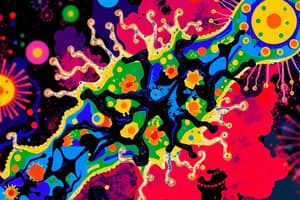Podcast
Questions and Answers
What is one of the first lines of defense in the nonspecific immune system?
What is one of the first lines of defense in the nonspecific immune system?
- Skin (correct)
- Antibodies
- T lymphocytes
- Phagocytosis
What are interferons?
What are interferons?
Proteins secreted by virus-infected cells that inhibit neighboring cells from making new viruses.
Neutrophils have a long lifespan in the body.
Neutrophils have a long lifespan in the body.
False (B)
The major histocompatibility complex (MHC) acts as a _____ fingerprint unique to each individual.
The major histocompatibility complex (MHC) acts as a _____ fingerprint unique to each individual.
What role do macrophages play in the immune response?
What role do macrophages play in the immune response?
Which type of immunity is based on the circulation of antibodies?
Which type of immunity is based on the circulation of antibodies?
The complement system can only function in specific immunity.
The complement system can only function in specific immunity.
Match the following immune cells with their function:
Match the following immune cells with their function:
A local inflammatory response is triggered by _____ damage.
A local inflammatory response is triggered by _____ damage.
What do complement proteins do in the immune system?
What do complement proteins do in the immune system?
What is the primary role of mast cells in the immune response?
What is the primary role of mast cells in the immune response?
Flashcards are hidden until you start studying
Study Notes
Nonspecific (Innate) Immune Mechanisms
- Skin and mucous membranes are the first lines of defense against infection.
- Mucous membranes are found in the oral cavity, respiratory tract, digestive tract, and urogenital tract.
- Mucous membranes are composed of epithelial cells and a layer of mucus that traps microorganisms.
- Saliva contains enzymes that break down bacterial cell walls.
- Gingival crevicular fluid helps to wash away bacteria and contains antimicrobial agents.
Second Line of Defense
- Interferons are proteins produced by virus-infected cells that inhibit the spread of the virus.
- Complement proteins can be activated by the immune system to lyse bacteria, opsonize bacteria, and attract phagocytes.
- Inflammation is a local response to injury or infection.
- Inflammation is characterized by redness, swelling, heat, and pain.
- Inflammation is triggered by the release of histamine from mast cells.
Immune Cells
- Phagocytosis is the process by which cells engulf and destroy microbes.
- Neutrophils are the most abundant white blood cells and are the first to arrive at the site of infection.
- Neutrophils are short-lived because their primary function is to destroy invaders.
- Monocytes mature into macrophages, which are long-lived phagocytic cells that remain in tissues.
- Macrophages can also present antigens to lymphocytes to initiate specific immune responses.
Major Histocompatibility Complex (MHC)
- MHC proteins are cell surface markers that identify cells as "self" or "nonself".
- MHC Class I proteins are found on all nucleated cells.
- MHC Class II proteins are found on macrophages, B cells, and activated T cells.
Specific (Adaptive) Immune Mechanisms
- Humoral immunity involves the production of antibodies by B cells.
- Antibodies recognize specific antigens and can neutralize toxins, activate complement, and trigger phagocytosis.
- Cell-mediated immunity involves the activation of T cells, which can directly kill infected cells.
- T cells can also stimulate B cells to produce antibodies.
Role of Complement in Inflammation
- Complement activation, triggered by bacterial infection, leads to the production of C3a and C5a.
- These anaphylatoxins induce mast cell degranulation, releasing proinflammatory cytokines like IL-1, IL-6, and TNF-α.
- These reactions contribute to the vascular changes associated with inflammation.
Host-Bacterial Interactions in Periodontal Disease
- The primary role of neutrophils in controlling bacterial infections is through chemotaxis, phagocytosis, and killing mechanisms.
- Neutrophils migrate to the site of infection by "rolling," "margination," and "diapedesis."
- Selectins and integrins are key molecules involved in leukocyte adhesion to the endothelium.
- Bacterial lipopolysaccharide (LPS) stimulates the production of selectins and chemokines that attract neutrophils.
- Neutrophils release matrix metalloproteinases (MMP-8), which may contribute to tissue destruction.
- P. gingivalis, a periodontal pathogen, can evade neutrophil function by inhibiting chemotaxis and preventing IL-8 secretion.
- Opsonization, the coating of bacteria with antibodies or complement, facilitates efficient phagocytosis by neutrophils.
Antibody Response in Periodontal Disease
- Specific antibodies play a crucial role in controlling periodontal infections.
- Scaling and root planing, a periodontal treatment, stimulates the production of antibodies against periodontal pathogens.
- Antibodies facilitate phagocytosis and neutralization of bacterial toxins.
- In aggressive periodontitis (LAP), the absence of a host antibody response may contribute to disease progression.
Phagocytosis and Killing Mechanisms
- Once a bacterium is engulfed by a neutrophil, it is contained within a phagosome.
- Oxygen-dependent and oxygen-independent mechanisms are responsible for bacterial destruction within the phagolysosome of neutrophils.
- Oxygen-independent killing mechanisms rely on the release of lysozymes, cathepsin G, and α-defensins.
- The oxygen-poor environment of the periodontal pocket may impair oxidative killing mechanisms.
- Some periodontal pathogens, like A. actinomycetemcomitans, have evolved virulence mechanisms to evade phagocytosis.
Periodontal Manifestations of Neutrophil Disorders
- Neutrophil disorders can lead to severe periodontal destruction affecting both primary and permanent dentition.
- Disorders that affect neutrophil chemotaxis and phagocytosis are associated with aggressive periodontitis.
Studying That Suits You
Use AI to generate personalized quizzes and flashcards to suit your learning preferences.




